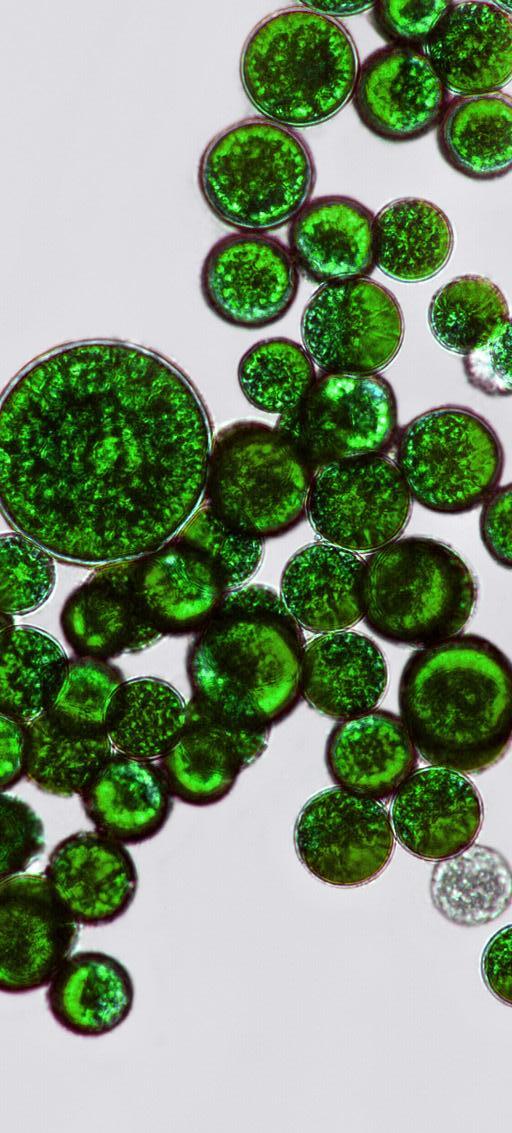Vitafoods Europe 2024: Putting people –and planet – first





Sustainability is at the heart of everything we do at Vitafoods Europe. Through our content programme, community, and purposeful partnerships, we provide our stakeholders with the tools to put people – and planet –first.
In this e-magazine, we take a look at some of the hottest topics on the sustainability agenda at this year’s event.
From renewable crops like seaweed and emerging technologies such as plant cell cultivation, to ensuring nutrition resilience and harnessing the power of big data to fill the research representation gap, we round up the biggest questions and challenges facing the supplements industry today.
If you haven’t registered for the show yet, click here to book your spot!

 By Anthony Fletcher
By Anthony Fletcher
The cultivation of seaweed could help to sustainably feed a growing global population, replace fertilisers, and restore biodiversity to the oceans.
At this year’s Vitafoods Europe Future of Nutrition Summit, Vincent Doumeizel, senior adviser to the United Nations Global Compact, will outline the critical role that industry can play in helping make this a reality.
Conventional food systems alone simply cannot meet demand from a growing global population without causing irreparable environmental damage. Crop yields are not increasing sufficiently, while arable land is shrinking.
“We need to increase the performance of food production systems without continuing to contribute to climate change, water scarcity, biodiversity loss, and social injustice,” says Doumeizel. “It has been calculated that we will need to produce as much food over the next 50 years as has ever been produced by mankind over the past 12,000 years.”
Doumeizel began his career over 20 years ago in Africa, working for the French government to support international aid. He has since focused on tackling global hunger and dedicated his career to finding ways of improving food systems.
In addition to his work at the UN Global Compact, Doumeizel is director of the food programme at Lloyd’s Register Foundation.
“I realised that there is no solution on land – the only solution is to look to the ocean,” he says. “Oceans cover 70% of the planet, yet contribute just 2% of our food. We need to build something regenerative here, and to do this we need to start at the foundations –plankton and seaweed.”
Doumeizel notes that seaweed extracts are already widely used as flavourings, texturing agents, and gelling agents, and that they are packed with nutrients such as vitamin C, vitamin D, zinc, iodine, and protein. There are also lots of bioactive compounds still to be fully investigated.
“Seaweed also has huge potential for use in animal feed, designing new types of fertiliser, and making bio-plastics,” he says. “It can help restore ocean biodiversity and sequester more carbon than any land forest. Some seaweeds can grow up to 40 cm a day, and up to 60 m high.”
In order to fully tap this potential, stakeholders will need to work together to establish a robust and sustainable seaweed cultivation industry. How this can be achieved will be a central element of Doumeizel’s presentation at the Vitafoods Europe Future of Nutrition Summit 2024.
Doumeizel intends to highlight the fact that industry is a key driver of change.
“If there is no demand for seaweed ingredients, then a viable industry simply won’t emerge,” he says. “We need to raise awareness, learn how to grow seaweed properly, and learn how to extract ingredients in a sustainable way. We need to avoid solvents and other chemicals. We need to support science.”
Doumeizel has already helped to foster interest from industry and policymakers – for example, through encouraging schemes to grow and harvest seaweed on offshore wind farms.
The success of such actions led Doumeizel and his colleagues at the UN Global Compact to publish the Seaweed Manifesto. This call to action highlights many of the key benefits, market potential, and obstacles that must still be overcome.
Doumeizel is also currently heading up the Global Seaweed Coalition, hosted by the UN Global Compact and supported by a grant from Lloyd’s Register Foundation. This is the first global platform of its kind to advocate for a strong seaweed industry.
“Anyone can join us, from small seaweed producers to major multinational manufacturers and everyone in between,” says Doumeizel.
“There is so much potential in the North and South Atlantic, around Australia, New Zealand, and South Africa, as well as the Nordic countries, Canada, and Greenland. There is also potential for some tropical seaweed activity around Indonesia and the Philippines, and Africa and India will be key players, too.”
“ANYONE CAN JOIN US, FROM SMALL SEAWEED PRODUCERS TO MAJOR MULTINATIONAL MANUFACTURERS AND EVERYONE IN BETWEEN.”
 By Tessa Wiles
By Tessa Wiles
Unlocking the potential of sustainable agriculture, three biofortified bean varieties have been released in Colombia, promising resilience to drought and the ability to combat hidden hunger.
For the four million Colombians dependent on coffee cultivation and earning less than $2 a day, hidden hunger – the presence of multiple micronutrient deficiencies – is a daily reality.
Three biofortified pulse/bean varieties – BIO103-SGA, BIO105-SGA, and BIO109-SGA – have been introduced in a collaborative effort between the National Coffee Research Centre (Cenicafé), the Alliance of Bioversity International, the International Center for Tropical Agriculture (CIAT), and Semillas Guerrero y Asociados.
Specifically designed for intercropping with coffee, these beans not only promise higher yields with their bushy growth habit but also hold the potential to address hidden hunger among coffee farmers.
Micronutrient deficiencies impact a significant portion of the global population. A 2022 study highlighted in an article by Vitafoods Insights suggests that one out of two preschool-aged children and two out of three women of reproductive age worldwide are affected by vitamin and mineral deficiencies.
Varying in size, shape, and colour, the three bean varieties aim to address micronutrient deficiencies in Colombia by providing more than sustenance.
María Carolina González, PhD research scientist and team leader at Biofortified Crop, told Vitafoods Insights: “The three released varieties focused on the micronutrient zinc, which helps the neurocerebral development of children from zero to five years old, pregnant women and increases people’s defences.”
Providing up to 39% of the daily iron requirement and 41% of the zinc requirement, they stand as nutritional powerhouses – 1.5 times richer in minerals than conventional beans.
Utilising traditional, non-GM plant crossbreeding techniques and field evaluations, these biofortified beans showcase not only their nutritional richness but also their adaptability to coffee intercropping.
“Planting beans intercropped with coffee does not interfere with coffee development,” said González. “[It] allows farmers to improve their food and nutritional security by consuming more nutritious food, while providing them with an alternative source of income during the growing phases of the coffee crop.”
“AS LEGUMES, BEANS HELP TO FIX NITROGEN FROM THE ATMOSPHERE, WHICH IMPROVES SOIL FERTILITY.”
Extending beyond addressing hidden hunger, these beans contribute to sustainability. González said: “As legumes, beans help to fix nitrogen from the atmosphere, which improves soil fertility.”
The beans, with tolerance to certain pests, diseases, and drought, align with the changing climate patterns in Colombian agriculture. González explained that these features reduce the need for chemical inputs, minimising the environmental impact.
Discussing the crossbreeding process, she said: “These lines were generated using a traditional breeding method. The method was a three-way cross and advanced for six generations by selfing.”
This process, spanning eight to ten years, involves advanced line generation, agronomic trait identification, molecular tools, farmer condition testing, and the final release.
Through crossbreeding and extensive field evaluations, these biofortified beans cater to the diverse needs of over half a million coffee-growing families across 23 Colombian departments, covering approximately 842,000 hectares.
Beyond addressing immediate nutritional needs, the initiative emphasises a broader perspective, integrating climate-resilient crops into the farming landscape. With a bushy growth habit that requires fewer inputs, these beans contribute to overall agricultural sustainability, reducing production costs.
As the project envisions the commercialisation of surplus beans, it isn’t just about income improvement for coffee growers.
González said: “The release of these varieties was carried out in conjunction with a private agent, which will allow their availability and commercialisation.
“The biofortified programme of the Alliance Bioversity – CIAT does a lot of work in promoting and disseminating biofortified varieties, which results in farmers being able to know and use them so that more families can access more nutritious foods.”

Sustainability and transparency in global supply chains are moving from voluntary to mandatory regulation. Businesses should avoid a reactive stance towards increasing legislative and consumer pressure. The wiser strategy for ingredient buyers in the nutraceuticals industry and beyond is to tackle the issues head-on. Start by understanding where your ingredients are sourced, how they are produced, and under what circumstances.
To provide insight on how to do this, Informa is partnering with Solidaridad, an international civil society organisation with 50plus years of experience in working on sustainability with partners throughout the supply chain, with a special focus on small growers.
Take, for example, Solidaridad’s work in the tea supply chain in India. For over a decade, Solidaridad has trained small tea growers in good agricultural practices and the production of high-quality tea. Key here was Solidaridad’s introduction to its SoliTrace technology, allowing for sustainability assessments and data-gathering on a defined set of sustainability indicators in support of full traceability, transparency, and storytelling.


Representatives from Solidaridad will be attending Vitafoods Europe 2024 Click here to connect with them and arrange a meeting during the event.

 By Kirstin Knight
By Kirstin Knight
Scalable, nutritious, and easy to grow: the water lentil is a superfood with sustainability credentials that pack a punch.
Also known as duckweed, the smallest flowering plant on earth grows with 15 times less water than soybeans, doubles in biomass every 24 hours, and can be cultivated on “any type of land”, said Susan Payne, co-founder and chief operating officer of Sustainable Planet.
The UK-based startup is developing an alternative plant protein source from water lentils that can be used in functional foods and supplements.
“We believe that we can heal the planet,” she told an audience at the 2023 Future of Protein Production event in Amsterdam.
The United Nations has advised that, due to population growth, we need to increase food output by 50 to 70% over the next 25 years.
However, a lack of arable land – not to mention desertification, saline intrusion, drought, and water and food scarcity – all pose challenges for global protein production.
The solution proposed by Sustainable Planet? Take non-arable land, such as salt flats or sandy soil, and use it to grow water lentils.
Due to its high level of protein, the plant is six times more efficient than soy, which causes large-scale deforestation.
“It’s a climate hero – it’s actually a carbon sink,” Payne said.
Soybeans may be the number one plant protein in the world, but water lentils “can actually match or improve” on “every single item”, she claimed.
They are resource-efficient and highly productive: a hectare of land will produce four tonnes of soybeans per year, whereas a hectare of water lentils will produce 30 to 40 tonnes per hectare per annum under conservative estimates, up to 100 tonnes per hectare per year.
“Water lentils produce 10-15 times more protein per hectare than soybeans using about 10 to 15 times, if not more, less water,” said Payne. “It’s a quite a dramatic equation.”
If global soy production were converted to water lentils, there would be a one gigaton reduction in the annual CO2 emissions produced by agriculture – about 15 gigatons currently, she added.
Not only is it sustainable – the water lentil is a “super protein” with a wide range of applications.
It has a perfect amino acid composition; is gluten-free, low-carb, and soy-free; and contains a wide range of micronutrients. What’s more, it has higher levels of calcium, iron, amino acids, fibre, and omega-3 than spirulina or chlorella, Payne said.
It can be added to protein shakes, eaten raw in salads, and used as a functional protein booster in breads, pastas, and cereals.
Sustainable Planet has an exclusive global license agreement with Wageningen University and Research (WUR) on its patent to extract a colourless, odourless isolate from water lentils.
The startup, which was founded in 2019, has been trialling its concept for water lentil production in different parts of the world. Its flagship programme is in Mozambique but it has runs trials across eight countries, including Oman, Thailand, and Egypt, with “very good results”, said Payne.
Sustainable Planet is “very strongly focused” on sub-Saharan Africa, where as many as 60% of the population work in agriculture, mostly as smallholder farmers. Water lentils offer the opportunity to create “thousands of jobs” in the continent, Payne said.
“We work with those smallholder farmers… and we can pay them three to five times more than they’re currently earning on their lands,” she added. “We can give them education and training, we can give them better nutrition, [and] we can further diversify their crops, which is important when they’re losing money in maize.”
The company is also producing products within countries that require humanitarian aid, such as Iraq, where farmers can combine local products, such as bananas or dates, with the water lentil to create nutritional bars, for example.
“[I]n the Middle East, [we’re] growing protein on sandy soil, using local dates and creating a date protein bar that can be used for humanitarian purposes,” said Payne.
Ultimately, producing protein from water lentils is a win for people as well as the planet, she claimed.
“It’s regenerative,” she said. “We can use brackish water, we can use saline water, we can use grey water to produce this output. It doesn’t have to be pure water. It doesn’t have to be good land. And we can still produce a very high-quality superfood from those second-grade inputs – and that is really unusual.
“And that is why we believe that we can have quite a strong empowering impact on not only subsistence farmers, but also communities and countries.”
Many groundbreaking discoveries credited with saving lives could never have been made without the inclusion of individuals of African descent in genomics research.
Yet almost nine in 10 genomics studies are conducted in individuals of European descent – while Africa represents a tiny 1.1%.
These stark statistics hint at an untapped opportunity to conduct research that can benefit all populations, according to Segun Fatumo, associate professor of genetic epidemiology and bioinformatics at the London School of Hygiene and Tropical Medicine.
“We are doing ourselves harms if genomic study is not diversified to include Africans and other underrepresented populations,” he told Vitafoods Insights
A 2022 paper in Nature Medicine on which Fatumo was lead author showed that in 2021, 86.3% of genomics studies were conducted in individuals of European descent, followed by East Asian (5.9%), African (1.1%), South Asian (0.8%), and Hispanic/Latino (0.08%) populations.

This represents an increase in the proportion of samples from individuals of European ancestry – which stood at 81% in 2016 – while the proportion of samples from underrepresented populations has stagnated or decreased.
Asked why this disparity was continuing to widen, Fatumo said: “Despite the warning [about the lack of diversity in genomics research], people are studying even more European populations – so even if African and other underrepresented populations try to catch up, they cannot.”
However, the need to equitably study all populations remains paramount, he said –particularly in the case of African individuals, who harbour far greater genetic and linguistic diversity than other populations.
As many as 90% of African ethnolinguistic groups have no representative genetic data to date; studying a small number of diaspora populations and grouping participants into one broad category of African ancestry will continue to promote imbalance and widen health disparities.
“If you don’t study Africa, you are not going to capture [that] diversity and capture those genetic variants that might be important for maybe the next [miracle] drug,” Fatumo said.
Intersecting identities also have implications for how different people respond to health interventions, Fatumo explained.
“Apart from including different ethnic group in genomics studies, we also need to think about if we are also including representation of different genders,” he said.
Race, ethnicity, and gender all have an influence on how compounds are metabolised in the body, meaning that some individuals may require different dosages of some medications to achieve the same effects as others.
“If we don’t study different kinds of people, different kinds of genders, different kinds of ancestry, you would not know how to administer the appropriate [amount] of medication,” Fatumo said.
Fatumo highlighted some breakthroughs in our understanding of metabolic disease that could never have been made without research in diverse populations.
For example, a treatment for lowering low-density lipoprotein (LDL) cholesterol could not have been developed without a study on the enzyme PCSK9 –which plays a role in the regulation of LDL receptors – that included individuals of African ancestry, in whom the researchers discovered a genetic variant.
Fatumo said: “Because they included African ancestry individuals, now we have a class of drug from this PCSK9 that is very useful for all populations.”
Another example is a drug targeting the APOL1 gene variant, which is implicated in kidney disease. This variant is between three and five times more frequent in Africa than in other populations, particularly in West Africa and Central Africa, Fatumo explained, putting people of African descent at an increased risk of developing kidney disease.
Meanwhile, research published in Nature earlier this year identified a genetic variant that may explain why some people of African ancestry have naturally lower viral loads of HIV. This variant, near the CHD1L gene, holds potential as a drug target for HIV, Fatumo said.
Fatumo used a personal example from several years ago when he went to the GP and was told he had diabetes. In the UK, the most commonly used blood test for diabetes is HbA1c; however, Fatumo knew that this was not appropriate for him “because I have sickle cell traits, which is not very common in the UK”.
In Africa, about 20% of people have sickle cell traits, and this is a factor taken into consideration during testing. However, it took many months before the British doctor asked Fatumo to do a different test and established that he did not, in fact, have diabetes.
Fatumo said this was just one example of why the shift towards precision medicine, wherein patients’ healthcare takes into consideration their characteristics – “most importantly, their genomics and epigenetics” – is so important.
The current one-size-fits-all model results in treatment that is only effective for about 20% of the population, he said – “whereas if we have a tailored approach for precision medicine… people have more appropriate treatment. The future is precision medicine”.
Asked about industry attitudes towards addressing these disparities, Fatumo said some pharmaceutical companies were looking to play a role in supporting study in African populations – for example, via providing funding for African Centres of Excellence.
“For some companies, they have a lot to do,” he said. “I think now they realise that.”
However, he admitted that there was reluctance from other players, which most probably came down to the question of profit.
“If you have medication for the UK or the West, for example, you make your money, but if you are dreaming of Africa, maybe they don’t see any big markets there,” he said. “But I think we are in the era where we need to think beyond that.
“We need to … think about how many lives can we save and maybe think about long-term profits in terms of people living longer.”
 By Tessa Wiles
By Tessa Wiles
Many Swiss consumers are hesitant to try current microalgae products – but researchers have identified “clear opportunities” and an untapped demand for healthy processed foods with algae, such as natural snacks.
How do we bridge the gap between microalgae’s potential and consumer adoption?
A study from Bern University of Applied Sciences in Switzerland has attempted to answer this question by studying consumer attitudes toward microalgaebased foods.
Microalgae consumption is not a new phenomenon: humans have been consuming it for thousands of years, predominantly in coastal regions. From the Dead Sea to Antarctica, more than 50,000 different types of microalgal species grow in abundance, tolerating varying temperatures, conditions, and environments.
From mitigating CO2 to serving as potential health foods and sustainable meat alternatives, microalgae hold promise for both environmental and dietary sustainability.
Vincent Doumeizel, senior adviser to the United Nations on oceans and food, and author of The Seaweed Revolution, shared his perspective on aquaculture production at the Future of Nutrition Summit, held as part of Vitafoods Europe’s sister event, Food Ingredients Europe 2023.
He said: “We have only focused on land. It is now time to get civilised with the ocean.”
Despite annual protein production potential ranging from four to 15 tonnes of protein per hectare, microalgae-based foods’ limited availability in the market prompts questions about consumer willingness to adopt them into their diets.
The Bern University study surveyed 584 participants, employing cluster analyses to categorise consumers based on their perceptions and attitudes toward microalgae. From this analysis, six distinct consumer segments emerged. The results indicated that behavioural patterns had a more significant influence on segment differentiation than sociodemographic variables.
Among these segments, the “microalgae supporters and health eaters”, constituting 18% of participants, stood out as the primary target group. Researchers identified them based on their positive attitudes, prior knowledge, and willingness to pay more for microalgae-based foods.
While their consumption rate of microalgae-based foods was less than one day per week – which the researchers linked to the current scarcity of such products in the market – this group displayed a low phobia toward novel food technology and a high interest in the natural content of food. The study suggests clear opportunities for targeting this group with processed microalgal-based foods like readyto-eat snacks or meat analogues that are free from additives or artificial ingredients.
The largest segment, comprising 23% of participants, was labelled “aware and open-minded”. This group had a positive attitude toward microalgae and agreed on its health benefits after receiving information, highlighting the influential role of education in reshaping perceptions.
The “uninformed but susceptible” group (22%) did not eat microalgae regularly and showed limited knowledge. Yet, the average attitude towards algae was positive, indicating opportunities for interventions to boost awareness.
The “innovative and adventurous” group (17%) felt positively about algae despite their limited knowledge, especially among the younger demographic, suggesting potential success through strategies that emphasise curiosity and health benefits.
Two groups were more sceptical towards microalgae. The “conservatives” (12%) exhibited neutral to slightly positive attitudes but had concerns about new food technologies, making them potentially difficult to target. They were unwilling to pay more for microalgae compared with conventional protein sources and did not believe microalgae would have a great future in the food industry.
The “microalgae avoiders and traditional” made up the smallest segment at 8%, and displayed scepticism and a lower willingness to adopt microalgae-based foods. This group was less interested in environmental protection and creativity while cooking, and overall, less involved with food in general.
Food neophobia – the reluctance to eat, or the avoidance of new foods – was identified as a potential hurdle for consumer acceptance. The study suggested that overcoming this obstacle requires concerted efforts, specifically targeting groups with high food neophobia.
Some companies are already working to overcome this challenge by adding microalgae into everyday staples.
Goodles, a US-based noodle manufacturer, uses chlorella, a freshwater microalga, in its range of pasta and ready-to-eat mac and cheese.
Additionally, Cerebelly, an organic baby food line founded by Dr Teresa Purzner, claims its products –rich in 16 key nutrients, including chlorella and kelp – support infants’ growing brains.
As we approach 2030, the significance of the United Nations Sustainable Development Goals becomes increasingly apparent. Microalgae stand as a potentially underused resource with the capacity to contribute to achieving these goals.
Doumeizel, emphasising the need to use oceans strategically and to cultivate seaweed, underscored the paradox that the ocean, spanning 70% of our world, contributes to less than 2% of our food. He said: “We have to stop being hunter-gatherers in the ocean.”
Be among the first to see, experience and take advantage of the latest innovations 14-16 May 2024 Geneva vitafoods.eu.com

 By Kirstin Knight
By Kirstin Knight
From conflict to climate change, a complex cocktail of crises is threatening the resilience of our food systems, jeopardising the nutrition and wellbeing of the world’s most vulnerable people.
That was the message from experts speaking at the Micronutrient Forum 6th Global Conference in The Hague, the theme of which was “Nutrition for Resilience”.
The urgency of this “polycrisis” could be felt not only on the show floor, where a diverse range of experts representing more than 100 countries were engaging in discussions about potential solutions, but on the streets outside, where peace protests were taking place.
As well as having direct health and economic impacts, this collection of crises is disrupting key systems including food, health, water and sanitation, education, and social protection – and in doing so, dramatically increasing the risk of poverty and insecurity for the most marginalised individuals in society.
At the conference’s closing ceremony, the Micronutrient Forum issued a “Way Forward” statement outlining six recommendations to strengthen the nutrition resilience of individuals, households, and communities.
“We – a group of deeply concerned experts from across research, academia, program and policy organisations, and governments – bring forward opportunities for immediate, evidence-based action by the international community to galvanise the momentum necessary to meet the Sustainable Development Goals’ promises for protecting nutrition and health in the face of unprecedented crises,” it reads.
“We fundamentally believe good nutrition is a human right – it is both a contributor to and an outcome of resilience. The need to strengthen nutrition resilience has never been more urgent, and the opportunities for action to do so are compelling and viable.
“We must work together immediately to ensure that current and future generations of children and their communities and nations are able to achieve their full potential.”
1
1. Scale up proven and cost-effective micronutrient interventions across food, health, and social protection systems
The statement calls for investment in low-cost, scalable micronutrient interventions, pointing to the “overwhelming evidence” from successful initiatives such as the promotion and protection of breastfeeding; large-scale food fortification and biofortification; and vitamin A and multiple micronutrient supplementation (MMS).
“Evidence shows that these interventions can help reduce mortality, prevent disabilities and cognitive deficits, improve growth and immune functions, strengthen population health, and build the resilience of communities to withstand future shocks,” it adds.
“Micronutrient interventions are among the highest-return investments in overall development: for example, $1 invested in MMS gives a return of $37.”
2
The statement acknowledges that gender equality and nutrition are “deeply interconnected”, adding: “Empowering women and girls is the foundation for nutrition resilience, and, in turn, improving women and girls’ nutrition is fundamental to increasing their own agency over their health, diets, productivity, empowerment, and ability to reach their full potential.”
It calls for urgent action to elevate anaemia in women and girls, urging “new stakeholders from diverse sectors” to come together to achieve this, and for prenatal provision common in higher-income countries to be expanded elsewhere.
It adds: “Food fortification strengthens food systems and makes nutrient-rich diets more affordable for women and adolescent girls. Improving the quality of prenatal services to include the provision of MMS as the standard of care, as is common in upper-income countries, can dramatically improve maternal health and pregnancy outcomes.”
3
3. Accelerate generation of data and evidence for impactful decisions and action
Robust, real-time information systems are required to measure the effectiveness of nutrition policies and programmes. This is where innovative tech can play a role, the statement’s authors argue, highlighting the gut microbiome and immune function as areas of interest.
“New and innovative technologies and digitisation can help monitor and track trends in nutrition and micronutrient status,” they write.
“Accelerated investments in fundamental, translational, and applied research and knowledge-sharing are critical to understand intractable and emerging issues of significant public health relevance, such as the nature and scale of nutrition-climate linkages and influence of micronutrients on long-term health, including the gut microbiome and immune function.”
4
4. Join forces with the climate sector to leverage and amplify shared agendas and solutions
The statement calls for all players across the board to contribute towards the shared climate agenda, arguing that scaling up access to nutrition services is “an essential part” of protecting communities against the crisis.
“Together with climate partners, we must support adaptation and mitigation efforts to enhance food and nutrition security, livelihoods, and resilience, as prioritised in the COP28 Emirates Declaration on Resilient Food Systems, Sustainable Agriculture and Climate Action,” it reads.
The authors highlight the level of transformation required for positive and lasting change, calling attention to examples such as “investments in adaptive and diverse production systems and markets, and the development of climate-resilient, nutritious, and indigenous crops”.
5. Invest in nutrition-resilient systems and programmes across humanitarian and development programmes to protect and maximise nutrition gains in the near and long term Countries with high levels of micronutrient malnutrition “also experience a continuum of interconnected and compounding development and humanitarian challenges that reverberate over years, if not decades”, the statement adds.
“Urgent investments are needed to build the nutrition resilience of programmes and national systems for continued access to nutrition services and nutrientrich foods that vulnerable communities depend on, particularly in crisis-prone contexts,” it reads.
It highlights the “robust evidence” for nutritionsensitive social protection programmes, and calls attention to potential lessons to learn from pandemic responses in different countries.
6. Accelerate the mobilisation of financing for food and nutrition security actions at scale
Building food- and nutrition-resilient systems
“demands moving beyond the traditional funding silos and mechanisms that have failed to deliver the necessary resources for nutrition”, the authors argue.
“Achieving impact requires that we bring in new national and global financing approaches and commitments across sectors by emphasising cobenefits (for example, climate co-benefits) and incentivising integrated actions across a continuum of contexts,” they add.
“WE FUNDAMENTALLY BELIEVE GOOD NUTRITION IS A HUMAN RIGHT.”

FMCG Gurus is one of the official content partners for Vitafoods Europe 2024.
FMCG Gurus provides market research and insight into consumer attitudes and behaviours across the food, beverage, and supplement markets worldwide. The leading global FMCG companies trust us to help them make more informed decisions by leveraging our services and solutions.
This infographic is based on the following FMCG Gurus survey series: Active Nutrition survey series 2023 (sample size: 24,000; 1,000 per country) and Sustainability survey series 2022 (sample size: 23,000; 1,000 per country).
Africa/Middle East: Saudi Arabia, South Africa, and the UAE
Asia-Pacific: Australia, China, India, Indonesia, Japan, Malaysia, Philippines, South Korea, Thailand, and Vietnam
Europe: Austria, Czech Republic, Denmark, France, Germany, Italy, Poland, Serbia, Slovenia, Spain, Sweden, The Netherlands, Turkey, and the UK
North America: Canada, Mexico, and the USA
South America: Argentina and Brazil.
59%
59% of global consumers believe the state of the environment has worsened in the last two decades.

71% of global consumers say they find upcycled ingredients appealing.
7 in 10
Over 7 in 10 global consumers say they are concerned about global warming.
74%
74% of global consumers say they are concerned about carbon emissions.

66% The proportion of consumers who have made greater efforts to reduce food waste in the last two years.



60%

66%
of consumers feel that food, drink and supplement brands should be doing more to protect the planet.




of global consumers find nut protein sources appealing.
 By Will Chu
By Will Chu
Ayana Bio has inked a seven-figure deal with Wooree Green Science to develop high-potency, full-spectrum saffron bioactives using plant cell cultivation instead of traditional agriculture.
Frank Jaksch, CEO of Ayana Bio, explained how climate change-driven crop failures are exacerbating an already constrained supply chain due to the plant’s labour-intensive harvesting needs.
Plant cell cultivation, he added, is a cost-efficient alternative production method that bypasses the constraints of agricultural supply chains.
“By creating bioactive ingredients with plant cell cultivation, we don’t need the land, irrigation, herbicides, or pesticides required by agriculture, or create wasted biomass to extract bioactives,” Jaksch said.
“It also solves the bioactive potency, quality, and standardisation problem, as it is very challenging to reliably obtain plant-based ingredients with consistent levels of plant bioactives sourced from agriculture-based supply chains.”
Ayana Bio’s plant cell cultivation approach, simply put, creates plant materials without growing plants in the ground. By growing real plant cells in stainless steel tanks, this process delivers the health benefits of plant bioactives without the quality issues that come from the constraints of conventional agriculture, including climate change.
The startup’s plant cell cultivation technology produces the full spectrum of bioactives found in nature – or with an even higher potency of beneficial bioactives.
“Historically, plant cell culture is not new, and cost, genetic instability, and scaling have been formidable challenges in achieving commercial scale for plant cell culture,” said Jaksch. “Because of significant advances in synthetic biology over the past 10 years, the technology necessary to develop plant cells to achieve cost and scale is now available.
“Ultimately, the successful commercialisation of plant cell programmes will be driven by the ability to select and optimise plant cells during the early stages of development.”
“BY CREATING BIOACTIVE INGREDIENTS WITH PLANT CELL CULTIVATION, WE DON’T NEED THE LAND, IRRIGATION, HERBICIDES, OR PESTICIDES.”
In the case of saffron, the journey starts with authenticated Crocus sativus plant material, which Ayana Bio uses to develop a callus. (In botany, a callus is the soft tissue that forms over a wounded or cut plant surface that leads to healing.) Once the callus is formed, the team adapts it to a liquid media to screen and observe growth and the metabolites that are produced.
“We use the power of multi-omics testing to identify the best cell line to produce the bioactives of interest and lock in the cell line for optimization,” said Jaksch.
He also highlighted Ayana Bio’s technology partner, Ginkgo Bioworks, and its role in analysing thousands of plant cell lines to select the best ones. “Once we have locked in the optimised plant cell line, we no longer need to continue using agricultural-derived material,” he said.
The agreement will specifically see plant cell-derived saffron and other bioactive ingredients for health and wellness products distributed in the South Korean market.
Um Tae Wook, CEO of Wooree Green Science, a subsidiary of South Korean firm Wooree Bio, said the company was excited to collaborate with Ayana Bio to create ingredients for applications across food and beverages, cosmetics, and pharmaceuticals.
Saffron is even more difficult to grow in face of climate change
Current growth methods require up to 170,000 flowers to produce just one kilo of saffron, making it a prohibitively expensive ingredient for supplements. Saffron also faces several climate change issues, like shifting weather patterns, pollution and water shortages in the limited number of countries where traditional production happens.
Despite the challenges, saffron remains an attractive botanical-based ingredient due to its role in aiding weight loss by suppressing appetite and increasing metabolism.
Ayana Bio’s ingredient portfolio includes various high-value ingredients with scarcity issues, such as hedge nettle, sage, echinacea, and lemon balm.
 By Kirstin Knight
By Kirstin Knight
More than half of respondents to a global survey assessing how prepared the supplement sector is with regards to environmental sustainability say the issue is of high relevance to their company.
But many said the costs associated with sustainable change, coupled with a lack of government support, were holding them back from doing more.
Simon Pettmann, executive director at the International Alliance of Dietary/Food Supplements Associations (IADSA), which conducted the survey, said it was intended to establish a “global benchmark”.
He told Vitafoods Insights: “This is about the global picture. This is about us all making sure that as a sector, we are properly engaged in sustainability and doing what we can, within the resources available, to keep making progress.”
The 2023 survey, which was conducted by IPSOS on behalf of IADSA, targeted companies and member associations in more than 25 countries around the world; 335 took part.
More than half (56%) of respondents said environmental sustainability was already of high relevance to their company; 17% said the issue would become more relevant over the next one or two years, and 18% said it would become relevant in the medium to longer term.
However, responses uncovered differences between the approaches of multinational corporations (MNCs) and small- and medium-sized enterprises (SMEs).
MNCs were more likely than SMEs to identify investor expectations and pressure from employees as important driving factors for sustainability: 74% of MNCs said investor expectations were “very” or “fairly important”, compared with 49% of SMEs, while 73% said the same of pressure from employees, versus 59% of SMEs.
MNCs were also more likely to identify compliance with regulations and legislation (67% vs. 49%) and supply chain preparedness (42% vs. 27%) as “very important” factors.
“We know that many of the larger companies have been addressing sustainability for years – some for decades,” said Pettman. “But we also know that, for many SMEs, it’s a new issue.”
“MANY OF THE LARGER COMPANIES HAVE BEEN ADDRESSING SUSTAINABILITY FOR YEARS – SOME FOR DECADES.”
Asked what, if anything, was holding their company back from focusing, or doing more, on environmental sustainability, almost half of respondents mentioned the cost to the consumer (48%), while a similar proportion cited the cost to the company itself (44%). Around one-third mention a lack of government support or incentives (34%).
More MNCs than SMEs pointed to the cost of sustainability actions to the end consumer as a factor holding their business back – 55% compared with 37%.
This echoed the findings of a 2023 Vitafoods Insights survey, which found that 84% of European nutraceutical industry players are in favour of governments establishing a minimum legal standard for corporate sustainability and due diligence, with 76% saying companies should be penalised for noncompliance.
But while there was broad agreement that sustainable values should be core to business operations, the question of who should shoulder the cost was somewhat trickier.
More than half (58%) of the Vitafoods Insights survey respondents agreed that nutraceutical companies should do business in a more environmentally sustainable way, and that they should be prepared to accept a reduction in profits to achieve this.
However, most participants also said they wanted to see consumers shoulder responsibility for increased costs. Almost four in 10 (39%) strongly agreed that consumers should buy food supplements and nutraceuticals produced in an environmentally sustainable way and be prepared to spend more money on such products, with more than a quarter (27%) somewhat agreeing with this statement, the Vitafoods Insights survey revealed.
Just 9% strongly disagreed, while 12% somewhat disagreed.

The IADSA survey reflected a range of goals in businesses’ sustainability objectives. The most widespread practices cited were employing responsible marketing and labelling (86%); ensuring food supplements contribute to healthy and sustainable diets (86%); preventing negative impacts of the production chain on the environment (84%); minimising food and packaging waste (84%); and working towards responsible sourcing in the supply chain (81%).
However, Pettmann highlighted that sustainability was about people as well as the planet, pointing to the nutrition targets within the UN’s sustainable development goals (SDGs).
“[Fewer and fewer] people can afford to have a healthy diet,” he said. “What can be done about that? Do we have a role as a supplement sector? How can we work with government to … achieve these targets that have been set to 2030? That’s a whole other piece of it.”
Indeed, a Chatham House report entitled The Business Case for Investment in Nutrition described adequate nutrition as “the missing link for sustainable growth”.
“Tackling malnutrition would bring benefits for many aspects of the sustainable development agenda, from poverty reduction to gender equality,” it read, adding: “For enlightened investors and companies, the potential for improved nutrition – both in the workforce and in the communities in which firms are embedded – to drive inclusive and sustainable growth should be a compelling impetus for investment.”
Pettman said he hoped that the IADSA survey would build awareness at all levels.
He added: “We are raising awareness – we’re helping, in a way, the United Nations and other bodies to do that… [W]e give them a chance and we give our associations a chance to get this on the agenda.”
Keep up to date with ingredients trends and latest innovations

SIGN UP NOW


















 By Lynda Searby
By Lynda Searby
Food and nutraceutical companies must map their supply chains to comply with the upcoming Corporate Sustainability Due Diligence Directive. “You can’t just do this as a desk exercise in Europe –you need to go out there and speak to those who are affected by human rights and environmental impacts,” says nonprofit Solidaridad.
Now in the final stages of approval, the European Union’s Corporate Sustainability Due Diligence Directive (CSDDD) will require companies in the food and nutraceutical industries to identify and assess adverse human rights and environmental risks in their supply chains. Vitafoods Insights looks at what exactly this entails – and where should they start?
The CSDDD establishes obligations for companies to identify, assess, prevent, mitigate, address, and remedy actual and potential impacts on people and planet in their upstream supply chain and downstream activities. It places a particular emphasis on disclosures related to pollution and emissions, deforestation and damage to ecosystems, and human rights issues such as child labour and forced labour. It also introduces a legally mandated standard for how companies conduct supply chain due diligence.
There have been more dramatic twists and turns in the process to reach an agreement on the CSDDD than in a Hollywood action movie plot. The latest twist in the saga was on 15 March when, after weeks of delay, EU member states endorsed the directive after several changes were made to the draft.
While the core of the legislation remains intact, in order to reach a majority in the European Council and win over member states who were blocking the directive, several concessions were made. These included limiting its scope to companies with more than 1,000 employees and a worldwide turnover of more than €450 million.
Previously, the threshold for compliance was set at companies with more than 500 employees and a turnover of more than €150 million. There were lower thresholds for companies in high-risk sectors such as agriculture, food manufacturing, and trading of raw materials. However, high-risk sectors have been scrapped altogether in the latest draft.
Non-profit organisation Solidaridad, whose focus is fostering co-operation to make supply chains sustainable and equitable, is among those who feel that the compromises made to the directive have diluted its original ambition.
“We are disappointed with this last compromise as it means a lot of companies are now exempt from having to comply, which waters down the impact of the legislation,” Catarina Vieira, EU policy advisor for Solidaridad, told Vitafoods Insights
She said that calculations estimated the legislation would affect 5,500 companies in the entire EU. “In practice, the number of companies directly covered by the directive is quite small,” she noted.
However, she said that Solidaridad was happy with the supply chain due diligence requirement set out in the directive.
“We think it is sturdy and in line with international standards,” she said. “It requires meaningful stakeholder engagement, which we consider very important.”
As an example of this, Vieira said that under the requirements, companies are not allowed to
disengage with suppliers if they find a risk in their supply chain.
“It’s important to us, in working to protect smallholders and independent farmers, that legislation doesn’t lead to a ‘cut-and-run’ approach,” she said. “The directive requires companies who find risks to address those risks, not cut ties with that supplier and source somewhere else because it is easier.”
In this situation, she said the legislation requires that companies engage with stakeholders and can invoke responsible disengagement only after repeated attempts at mitigation.
The next step will be a vote in the European Parliament’s plenary session on 24 April, followed by a final vote in the EU Council. If, as is expected, the text is approved by both, the directive will be published. Member states will then have two years to transpose it into national law.
The enforcement of CSDDD will be staggered, so the largest companies (with more than 5,000 employees and a turnover in excess of €1,500 million) will be required to demonstrate compliance first. They will be given three years from the directive coming into force to meet their legal obligations. Companies that turn over more than €900 million will have four years and all other companies will have five years.
“THE DIRECTIVE REQUIRES COMPANIES WHO FIND RISKS TO ADDRESS THOSE RISKS, NOT CUT TIES WITH THAT SUPPLIER AND SOURCE SOMEWHERE ELSE BECAUSE IT IS EASIER.”
For many food and nutraceutical companies, this phased enforcement means it will be a while before the legislation is legally binding – but in some ways this is irrelevant, as it requires co-ordinated supply chain effort.
“There might be ingredient companies who don’t have any legal obligations now, but whose buyers do. Therefore, they are going to have to partner up and take a proactive approach to due diligence,” explained Vieira.
This works both ways in the supply chain. Addressing food and nutraceutical manufacturers, she said: “The issue might be in your supply chain but the solution might be closer to home. You can’t expect your suppliers to carry the burden of responsibility for fixing any problems that are identified.”
She added: “Companies are going to have to look in the mirror and change their own practices too, whether that means rethinking business models or adopting more responsible purchasing practices.”
On a practical level, Vieira said the good news is that there is plenty of guidance available as this directive has been aligned with international standards that have been around for decades.
“We’re talking here about the UN Guiding Principles on Business and Human Rights and the OECD Principles of Corporate Governance. Both of these instruments are out there already and provide companies with a starting point,” she said.
For many companies, she said the first step would be to look internally and make any changes necessary to enable a shift from a mentality of risk avoidance to one of risk assessment and mitigation.
“Companies should get all teams – sustainability, compliance, procurement, management, etc – on board with what is expected and how things should change. You also need to review your own practices for how they might be driving risks in your supply chains,” she advised.
She said this might include ensuring that business models are not squeezing suppliers on pricing, which could lead to a greater risk of human rights or environmental issues.
“YOU NEED TO REVIEW YOUR OWN PRACTICES FOR HOW THEY MIGHT BE DRIVING RISKS IN YOUR SUPPLY CHAINS.”
Companies also need to drill down into their supply chains, Vieira said.
“I am sure the majority of food and nutraceutical companies are already doing this, but you need to map your supply chains – figure out where you are sourcing from and what kind of risks are there. Talk to your suppliers and to rights-holders to ensure meaningful stakeholder engagement,” she said.
She added: “You can’t just do this as a desk exercise in Europe – you need to go out there and speak to those who are affected by human rights and environmental impacts, and get their input on what the risks are, how you should prioritise as a company, and what kind of solutions you can work on together.”

The Vitafoods Insights Webinar Series covers key nutraceutical market topics, offering attendees the opportunity to get up to speed on market trends, consumer insights, and ingredient innovations to create effective formulations.

